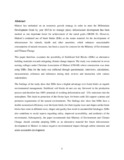| dc.description.abstract | Malawi has embarked on an economic growth strategy in order to meet the Millennium
Development Goals by year 2015.In its strategic plans; infrastructure development has been
marked as one important factor for achievement of the stated goals (MGDS II). However,
Malawi’s continued use of burnt bricks (BBs) as the mains material for the development of
infrastructure for schools, health and other amenities, which enhances unsustainable
consumption of natural resources, has been a cause for concern for the Ministry of Environment
and Climate Change
This paper therefore, examines the possibility of Stabilized Soil Blocks (SSBs) as alternative
building materials towards mitigating climate change impacts The study was conducted in seven
nursing colleges under Christian Association of Malawi (CHAM) where construction was done
using SSBs. Data for the study was collected through questionnaire, interviews, calculations,
measurements, reference and inferences during desk reviews and interaction with various
stakeholders.
The findings of the study show that SSBs have a higher advantage over burnt bricks as regards
environmental management. Stabilized soil blocks do not use any firewood in the production
process and therefore has 100% potential of avoiding deforestation and CO2 emissions into the
atmosphere. This leads to protection of the Ozone layer for better earth life support systems and
promotes regeneration of the natural environments. The findings also show that SSBs have a
double economical efficiency over the burnt bricks for their regular sizes and shapes unlike burnt
bricks that come in different sizes, shapes and quality that result in uncontrolled breakages. SSBs
also contribute to social aspects regarding safety, improved accessibility, and aesthetics of the
environment. Subsequently, the paper recommends that Ministry of Environment and Climate
Change should consider adopting SSBs as an alternative material for future infrastructure
development in Malawi to reduce negative environmental impact through carbon emission and
attain sustainable development | en_US |

